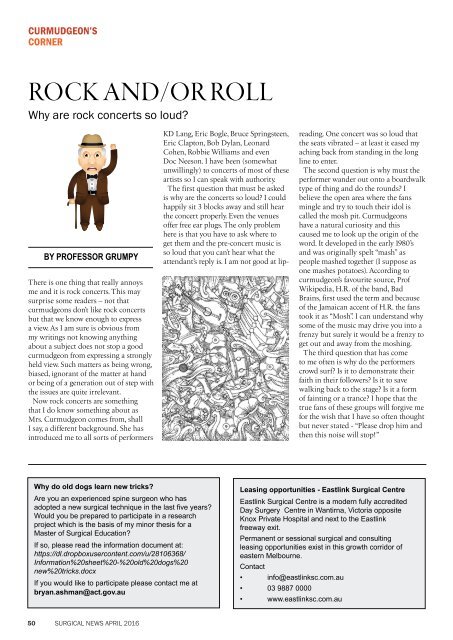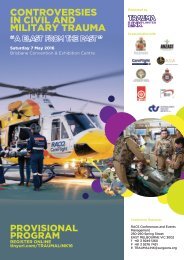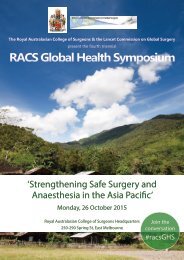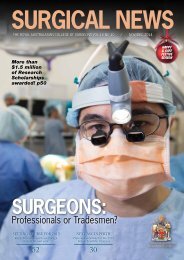You also want an ePaper? Increase the reach of your titles
YUMPU automatically turns print PDFs into web optimized ePapers that Google loves.
CURMUDGEON’S<br />
CORNER<br />
AUDITS OF<br />
<strong>SURGICAL</strong> MORTALITY<br />
ROCK AND/OR ROLL<br />
Why are rock concerts so loud?<br />
CASE NOTE REVIEW<br />
Allow time for preoperative assessment<br />
BY PROFESSOR GRUMPY<br />
There is one thing that really annoys<br />
me and it is rock concerts. This may<br />
surprise some readers – not that<br />
curmudgeons don’t like rock concerts<br />
but that we know enough to express<br />
a view. As I am sure is obvious from<br />
my writings not knowing anything<br />
about a subject does not stop a good<br />
curmudgeon from expressing a strongly<br />
held view. Such matters as being wrong,<br />
biased, ignorant of the matter at hand<br />
or being of a generation out of step with<br />
the issues are quite irrelevant.<br />
Now rock concerts are something<br />
that I do know something about as<br />
Mrs. Curmudgeon comes from, shall<br />
I say, a different background. She has<br />
introduced me to all sorts of performers<br />
Why do old dogs learn new tricks?<br />
Are you an experienced spine surgeon who has<br />
adopted a new surgical technique in the last five years?<br />
Would you be prepared to participate in a research<br />
project which is the basis of my minor thesis for a<br />
Master of Surgical Education?<br />
If so, please read the information document at:<br />
https://dl.dropboxusercontent.com/u/28106368/<br />
Information%20sheet%20-%20old%20dogs%20<br />
new%20tricks.docx<br />
If you would like to participate please contact me at<br />
bryan.ashman@act.gov.au<br />
KD Lang, Eric Bogle, Bruce Springsteen,<br />
Eric Clapton, Bob Dylan, Leonard<br />
Cohen, Robbie Williams and even<br />
Doc Neeson. I have been (somewhat<br />
unwillingly) to concerts of most of these<br />
artists so I can speak with authority.<br />
The first question that must be asked<br />
is why are the concerts so loud? I could<br />
happily sit 3 blocks away and still hear<br />
the concert properly. Even the venues<br />
offer free ear plugs. The only problem<br />
here is that you have to ask where to<br />
get them and the pre-concert music is<br />
so loud that you can’t hear what the<br />
attendant’s reply is. I am not good at lipreading.<br />
One concert was so loud that<br />
the seats vibrated – at least it eased my<br />
aching back from standing in the long<br />
line to enter.<br />
The second question is why must the<br />
performer wander out onto a boardwalk<br />
type of thing and do the rounds? I<br />
believe the open area where the fans<br />
mingle and try to touch their idol is<br />
called the mosh pit. Curmudgeons<br />
have a natural curiosity and this<br />
caused me to look up the origin of the<br />
word. It developed in the early 1980’s<br />
and was originally spelt “mash” as<br />
people mashed together (I suppose as<br />
one mashes potatoes). According to<br />
curmudgeon’s favourite source, Prof<br />
Wikipedia, H.R. of the band, Bad<br />
Brains, first used the term and because<br />
of the Jamaican accent of H.R. the fans<br />
took it as “Mosh”. I can understand why<br />
some of the music may drive you into a<br />
frenzy but surely it would be a frenzy to<br />
get out and away from the moshing.<br />
The third question that has come<br />
to me often is why do the performers<br />
crowd surf? Is it to demonstrate their<br />
faith in their followers? Is it to save<br />
walking back to the stage? Is it a form<br />
of fainting or a trance? I hope that the<br />
true fans of these groups will forgive me<br />
for the wish that I have so often thought<br />
but never stated - “Please drop him and<br />
then this noise will stop!”<br />
Leasing opportunities - Eastlink Surgical Centre<br />
Eastlink Surgical Centre is a modern fully accredited<br />
Day Surgery Centre in Wantirna, Victoria opposite<br />
Knox Private Hospital and next to the Eastlink<br />
freeway exit.<br />
Permanent or sessional surgical and consulting<br />
leasing opportunities exist in this growth corridor of<br />
eastern Melbourne.<br />
Contact<br />
• info@eastlinksc.com.au<br />
• 03 9887 0000<br />
• www.eastlinksc.com.au<br />
GUY MADDERN<br />
Chair, ANZASM<br />
Clinical details<br />
This is the case of a patient in their<br />
late-80s who underwent an elective<br />
total hip joint replacement (THJR).<br />
The patient was assessed preoperatively<br />
by the hospital pre-admission clinic<br />
(PAC) and then admitted the day<br />
before surgery for an anaesthetic<br />
review prior to surgery. The patient was<br />
graded with an American Society of<br />
Anesthesiologists (ASA) score of 2 and<br />
judged appropriate for surgery, although<br />
the exact level of risk according to the<br />
anaesthetist was not recorded. The<br />
patient underwent an uneventful and<br />
routine THJR the next day. The surgery<br />
took approximately 80 minutes and,<br />
other than some transient episodes<br />
of hypotension during the procedure,<br />
the patient had no obvious anaesthetic<br />
issues during the case.<br />
During the first 48 hours after the<br />
surgery, the patient displayed several<br />
episodes of mild hypotension, treated<br />
with intravenous fluids, and some<br />
confusion, particularly overnight.<br />
The patient also showed gradual<br />
deterioration in their oxygen saturation<br />
and was treated with nasal oxygen.<br />
Postoperative haemoglobin was 93<br />
g/L and the patient was subsequently<br />
treated with two units of packed cells.<br />
The patient had some renal impairment<br />
during this time, with a marginal urine<br />
output and a creatinine of 153 µmol/L.<br />
Approximately 54 hours after the<br />
surgery, the patient had a sudden<br />
onset of throat tightness, wheezes and<br />
decreased oxygen saturation which led<br />
to a transfer to the critical care unit for<br />
further treatment and monitoring. The<br />
patient was subsequently diagnosed<br />
as having had an acute myocardial<br />
infarction (AMI) and was worked up<br />
by the cardiology unit. The patient<br />
developed gradually worsening atrial<br />
fibrillation, hypotension and cardiac<br />
failure and then also developed possible<br />
pneumonia and sepsis. Renal function<br />
also gradually deteriorated and a family<br />
meeting was held to discuss the patient’s<br />
prognosis. After this meeting, a decision<br />
was made to provide palliative treatment<br />
only and the patient passed away 12<br />
days after surgery.<br />
Comments<br />
There are two possible areas for<br />
consideration in this case, both of which<br />
relate to the preoperative assessment of<br />
this patient. The management of this<br />
patient over the time of surgery and in<br />
the postoperative period was difficult<br />
due to age and medical comorbidities<br />
but, overall, was adequate and<br />
appropriate. Firstly, it is not clear if the<br />
patient was medically assessed at the<br />
PAC. If the patient had been, a referral to<br />
a cardiologist for assessment probably<br />
would have been appropriate and may<br />
have reduced the risk of this outcome.<br />
Secondly, the preoperative anaesthetic<br />
assessment occurred the day before<br />
surgery and after the patient had been<br />
admitted for surgery. This assessment<br />
may have been more appropriately<br />
carried out as part of the PAC to enable<br />
the opportunity for the anaesthetist<br />
to arrange further preoperative<br />
investigations and opinions, such as<br />
a cardiology review. The anaesthetist<br />
may feel pressured not to do this if<br />
the assessment occurs the day before<br />
surgery when the surgical team and,<br />
more importantly, the patient are<br />
otherwise fully prepared to proceed.<br />
IN MEMORIAM<br />
Our condolences to the family, friends<br />
and colleagues of the following<br />
Fellows whose death has been notified<br />
over the past month:<br />
Robert Peter Silverton<br />
Peter Court Grayson<br />
Victor Hadlow<br />
Lindsay Castles<br />
NSW<br />
NZ<br />
NZ<br />
Victoria<br />
RACS is now publishing abridged<br />
Obituaries in Surgical News. The full<br />
versions of all obituaries can be found<br />
on the RACS website at<br />
www.surgeons.org/member-services/<br />
In-memoriam<br />
Informing the College<br />
If you wish to notify the College of the<br />
death of a Fellow, please contact the<br />
manager in your regional office:<br />
ACT: Eve.Edwards@surgeons.org<br />
NSW: Allan.Chapman@surgeons.org<br />
NZ: Justine.Peterson@surgeons.org<br />
QLD: David.Watson@surgeons.org<br />
SA: Daniela.Ciccarello@surgeons.org<br />
TAS: Dianne.Cornish@surgeons.org<br />
VIC: Denice.Spence@surgeons.org<br />
WA: Angela.D’Castro@surgeons.org<br />
NT: college.nt@surgeons.org<br />
While RACS accepts and reproduces<br />
obituaries provided, we cannot ensure the<br />
accuracy of the information provided and<br />
therefore take no responsibility for any<br />
inaccuracies or omissions that may occur.<br />
50 <strong>SURGICAL</strong> <strong>NEWS</strong> APRIL 2016 <strong>SURGICAL</strong> <strong>NEWS</strong> APRIL 2016 51






